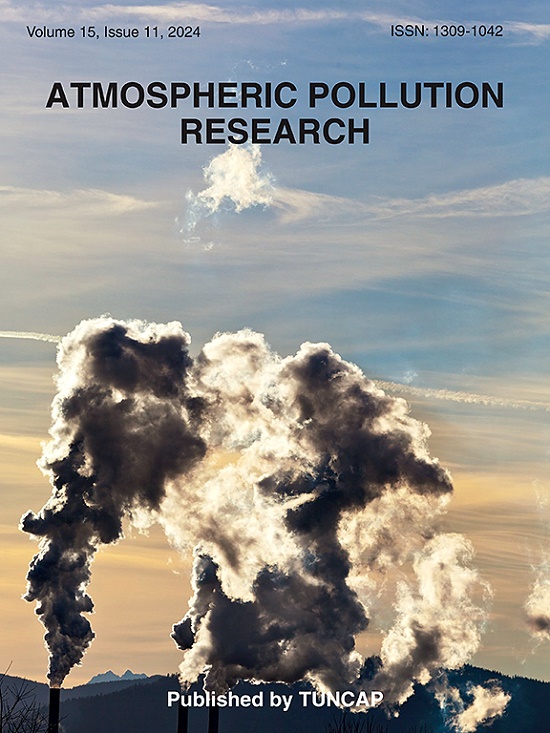厦门多环芳烃的季节变化和风险评估:洞察本地和远距离迁移源的影响
IF 3.5
3区 环境科学与生态学
Q2 ENVIRONMENTAL SCIENCES
引用次数: 0
摘要
多环芳烃(PAHs)是空气污染中毒性最大的污染物之一,具有严重的健康影响,但对其季节性特征和基于沿海城市本地和远程运输的特定来源的健康风险的研究还不够充分。本研究对中国厦门5个地区大气颗粒物中29种多环芳烃进行了详细的季节分析。研究发现,季风气候造成了明显的季节变化,冬季观测到的多环芳烃浓度最高(平均69.70 ng/m3),是夏季(平均23.88 ng/m3)的2.9倍。冬季较高的浓度主要是由于来自中国北方的污染气团的涌入。相比之下,夏季的水平下降可能是由于频繁降雨、更强的光化学降解和来自海洋的清洁空气团的稀释作用。主要污染源为交通运输排放(32.1%)、岩石源(30.5%)、生物质燃烧(28.5%)和煤炭燃烧(8.9%)。健康风险评价结果显示,冬季的健康风险最大,致癌性和诱变性风险是夏季的5.35倍,特别是集美等地区,交通相关多环芳烃占总风险的43.3%,而海沧地区溢油相关排放占该区致癌毒性的50%。女性面临的健康风险高于男性,靠近交通枢纽和工业区的风险更大。这些结果强调了外部污染对厦门市大气多环芳烃的影响,强调了有针对性地控制冬季污染的必要性。本文章由计算机程序翻译,如有差异,请以英文原文为准。
Seasonal variations and risk assessment of PAHs in Xiamen: Insights into the impacts of local and long-range transport sources
Polycyclic aromatic hydrocarbons (PAHs) are among the most toxic pollutants in air pollution with severe health implications, yet their seasonal characteristics and health risk based on specific sources from local and long-range transport in coastal cities are insufficiently studied. This research presents a detailed seasonal analysis of 29 PAHs in atmospheric particulate matter across five districts of Xiamen, China. The study found clear seasonal variations due to monsoon climate, with the highest PAH concentrations observed in winter (mean 69.70 ng/m3), 2.9 times higher than in summer (mean 23.88 ng/m3). The higher winter concentrations are mainly attributed to the influx of pollution-laden air masses from northern China. In contrast, the reduced levels in summer might be due to frequent rainfall, stronger photochemical degradation and the dilution effect of clean air masses from the ocean. The main sources were transportation emission (32.1 %), petrogenic source (30.5 %), biomass combustion (28.5 %), and coal combustion (8.9 %). Health risk assessments indicated that winter posed the greatest health risks, with carcinogenic and mutagenic risks up to 5.35 times higher than in summer, particularly in districts like Jimei, where traffic-related PAHs contributed to 43.3 % of the total risk, while Oil spill-related emissions in Haicang were responsible for 50 % of the carcinogenic toxicity in that district. Women face higher health risks than men, with greater risks near transportation hubs and industrial areas. These findings underscore the impact of external pollution on Xiamen's atmospheric PAHs, emphasizing the need for targeted winter pollution control.
求助全文
通过发布文献求助,成功后即可免费获取论文全文。
去求助
来源期刊

Atmospheric Pollution Research
ENVIRONMENTAL SCIENCES-
CiteScore
8.30
自引率
6.70%
发文量
256
审稿时长
36 days
期刊介绍:
Atmospheric Pollution Research (APR) is an international journal designed for the publication of articles on air pollution. Papers should present novel experimental results, theory and modeling of air pollution on local, regional, or global scales. Areas covered are research on inorganic, organic, and persistent organic air pollutants, air quality monitoring, air quality management, atmospheric dispersion and transport, air-surface (soil, water, and vegetation) exchange of pollutants, dry and wet deposition, indoor air quality, exposure assessment, health effects, satellite measurements, natural emissions, atmospheric chemistry, greenhouse gases, and effects on climate change.
 求助内容:
求助内容: 应助结果提醒方式:
应助结果提醒方式:


